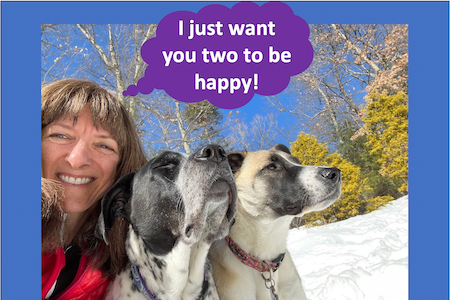Ever wonder WHY your dog’s sense of smell is so much stronger than yours?
If you spend any time around a dog, you quickly realize how much they use their nose. Dogs constantly check everything out in their world by putting their noses right in the middle of things, and make their next move after taking it all in.
A dog’s sense of smell is the main way they perceive the world. And it turns out, their sense of smell is way more sensitive than ours!
After learning about how a dog's sense of smell works, I have made conscious efforts to help them engage their noses more.

In order to explore this topic, I asked for an OK from my husband and dog Abby to use their images. I am not sure they exactly knew what their consent meant, but I hope the following diagrams and images better convey how a dog's and human's sense of smell compare at a basic level.

To get a sense of how much more “smell sensitive” a dog is to you and I, Alexandra Horowitz in her book, “Inside of a Dog: What Dogs See, Smell and Know” [1] describes an analogy:
If Humans can detect 1 teaspoon of Sugar in a Cup of Coffee, a dog can detect that same 1 teaspoon of sugar in over 1 Million Gallons of Water (the equivalent of 2 Olympic size swimming pools)

That, in my mind, is a phenomenal difference!
So WHY IS a dog's sense of smell so much stronger??
Before answering this question, let's first understand how we all actually smell anything...
In order to smell something, humans and dogs (and other mammals) have specialized cells in their bodies called “olfactory neurons” or “olfactory sensory cells” that trap odor molecules moving past them. Let’s call these cells “smell neurons” to make it easier.
These smell neurons have specialized “hair” or cilia at the end of them that are used to trap odor molecules wafting by.

When one of these smell neurons detects an odor molecule, it sends a signal onto the brain to process what we just smelled. It will let us know, “oh, this is a rose”, or “this is a new smell…” or “Coffee is ready!” But for that smell processing and awareness to happen, we and dogs need these smell neurons available and working to detect the odors.

Now here are some smell neuron differences between dogs and humans.
1. Dogs have A LOT MORE of these odor trapping smell neurons than humans do!
It is often quoted that dogs have 220 million plus smell neurons [2] and this number varies by breed. More short-nosed dogs such as Pugs and Pekingese have smaller surface areas in their nose to hold these cells so their average is about 125 million receptors. More “scent-oriented breeds” have wider and deeper noses that can pack in more smell neurons. The king of smell neuron numbers is the Bloodhound with around 300 million receptors. And interestingly enough a German Shepherd has around 225 million scent neurons, however, a Beagle (at one half the shepherd’s size) also has 225 million neurons! [3]

By contrast, it is often stated online as well as in my graduate school, human perception textbook [4] that humans have 6 million olfactory neurons. However, this number appears to be out of date and more recent articles put the number of smell neurons much higher and maybe up to 50 million [5] for humans.
But even if the number is up to 50 million receptors for humans, dogs still have a significantly larger number of odor trapping cells than humans.

2. The structure of smell neurons and other components are different in dogs than humans
At the end of each smell receptor cell are cilia (or little hairs) which house the odor receptors. Humans have approximately 25 of these cilia for each smell neuron [5], but dogs have hundreds of these little hairs for each smell neuron allowing them to detect much smaller concentrations of smells than humans [2].

The olfactory bulb, another critical component for processing the odor signals, is also much larger in dogs than humans and is positioned differently in the brain area.
3. Human and dog smell neurons live in different types environments
Smell neurons in dogs and people are both clustered in an area called the olfactory epithelium. However, there are some big differences in this specialized area…
- Where these smell neurons live
In people, this smell enabling structure is positioned on the roof of our nasal cavity [6].
Dogs, however, have a dedicated chamber [2] to house these smell neurons allowing smell molecules to be trapped for a longer period of time.
- What it looks like:
In people, this structure is generally very flat.
By contrast, the area where a dog’s smell neurons live, has LOTS of folds and crevices which both increases the surface area for the neurons to exist and allows for more contact time between the smell odors and the odor sensing neurons.
Scientists feel this structure difference is an important aspect as to why dogs smell better than us [7].

- Air Coming In and Going Out
In humans, the olfactory epithelium lives at the top of the nasal cavity. As we breathe, air and odor molecules move in, but the air and odor molecules also move out across the same area as we exhale reducing the amount of time that a smell neuron will have contact with an odor molecule.
For dogs, air and odor molecules come in through the front of a dog’s nostrils, but then about 12% is sectioned off to go separately into the dog’s olfactory epithelium space and even has a little flap to keep the air from traveling back out (2). The rest of the air goes to a dog’s lungs for breathing, but that smaller portion is separated out specifically for identifying smells. And again, this space in a dog, has LOTS of crevices and curves trapping those odor molecules even more!

4. How we each exhale
Next time you watch your dog breathe, take a closer look at their nose…
They take air into the front of their nostrils, but dogs use the sides of their noses to exhale! Where again, as humans, we take air in and push it out of the same area.

This mechanism is helpful in at least a couple of ways –
- When dogs are exhaling, the incoming air does not get disturbed by the outgoing air (like it does for humans). And again, this keeps the incoming scents around their smell neurons longer.
- When dogs are into a real “sniff mode” the outgoing air creates a little vortex that actually helps push the incoming air into the front of their noses for more concentrated and deliberate sniffing [2]. (think of how we sometimes will use our hands to fan a smell into our noses when we want to take in a good wiff…dogs do this automatically!)
Dogs also take in smells independently from their left and right nostrils allowing them to better determine what direction a smell is coming from.
4. Dogs have an additional “smell organ” called the Vomeronasal or “Jacobson’s” organ
This bit of extra smell hardware allows a dog to detect chemical signals and act upon them. This is where dogs can detect emotion, or if a potential mate has been around at some point. There seems to be a debate as to whether humans have such an organ, but, even if we have one, it does not seem to be internally wired for us to use it as other mammals do [8].
Given all of this extra capability, how can we support a dog’s sense of smell?
Once I came to appreciate how important a dog’s sense of smell is, I made some changes to help our dogs use their keen sense of smell more often. Here is a blog post on activities you can do outside - "How to Engage your Dog's Sense of Smell".
I also watch my dogs breathe more than I ever have before. I have become fascinated with how their noses work and have a greater appreciation for when they are truly engaged in their sniffing activities. I think about all the processing that must be happening and watch how much they enjoy doing it!
IN SUMMARY
Here are a few differences between how a human's and dog’s sense of smell works:
- Dogs have an order of magnitude more smell neurons than humans do
- The structure of the individual dog smell neuron is different – a dog’s neurons have more hairs at their ends to trap odors
- These smell neurons are held in different types of structures – in humans, the area is flat and incoming and outgoing air share the same space within the nasal cavity. In dogs, incoming air goes to a dedicated chamber with more surface area and curves and crevices giving greater exposure time between the odor molecules and the smell neurons.
- Dogs exhale air from the slits on the sides of their nose – allowing for less interference with air coming into the front of their nose and also creating a vortex to help drive air and smells more forcefully into the front of their nose.
- Smells coming into each side of a dog’s nose are processed separately for better smell location detection.
- Dogs have an additional operational organ, called the vomeronasal organ, for processing chemical / pheromone / emotional based odors. Humans do not have this organ working.
I hope you have enjoyed learning a bit about how a dog's sense of smell works. I know I enjoyed putting this information together!
References
[1] Horowitz, Alexandra. 2009. Inside of a Dog: What Dogs See, Smell and Know. Scribner.
[2] When the Nose Doesn't Know: Canine Olfactory Function Associated with Health, Management, and Potential Links to Microbiota
https://www.frontiersin.org/articles/10.3389/fvets.2018.00056/full
[3] Do some dog breeds have better noses and scent discrimination than others?https://www.psychologytoday.com/us/blog/canine-corner/201101/do-some-dog-breeds-have-better-noses-and-scent-discrimination-others
[4] Levine & Shefner. 1991. Fundamentals of Sensation and Perception – 2nd Edition. Brooks / Cole.
[5] The importance of the olfactory sense in the human behavior and evolution
https://www.ncbi.nlm.nih.gov/pmc/articles/PMC3018978/
[6] Olfactory epithelium
https://en.wikipedia.org/wiki/Olfactory_epithelium
[7] New details in how sense of smell develops - Findings could help determine how dogs evolved such good nose
https://www.sciencedaily.com/releases/2018/08/180810091607.htm
[8] Vomeronasal organ
https://en.wikipedia.org/wiki/Vomeronasal_organ

Gina Anderson...
founder of Good Paws Bakery and Gifts LOVEs to make dogs HAPPY! Prior to starting Good Paws, she was a human factors engineer making software easier for people to use. She loves learning about all things dog, and helping people understand things from a dog’s perspective. Connect with Gina on Linked In.

1 comment
This was a great article. Thanks for posting it. It explains why my dog, Oliver, can be out in the yard, house door shut, and he STILL can smell if I open a peanut butter jar. Unfortunately, he can’t have peanut butter, but I love it too. Now I tend to only eat it when he’s out on errands with “Dad” or when he’s at the groomers. lol
He still LOVES the apple treats you make, so I’m very glad you got that idea to use your apple tree for treats.
Thank you